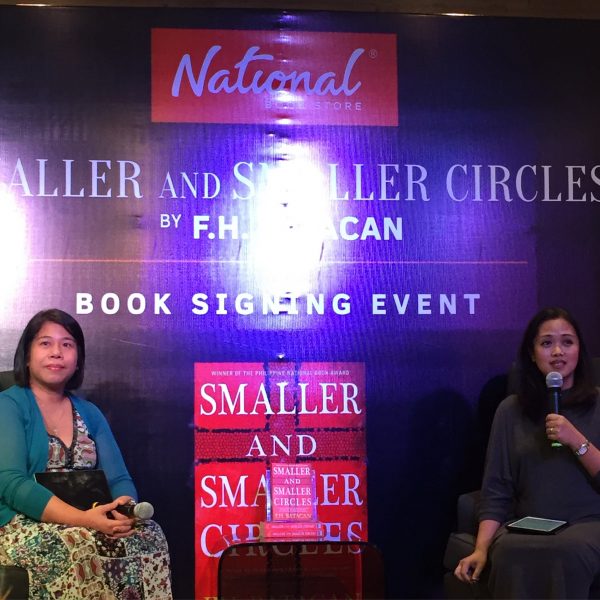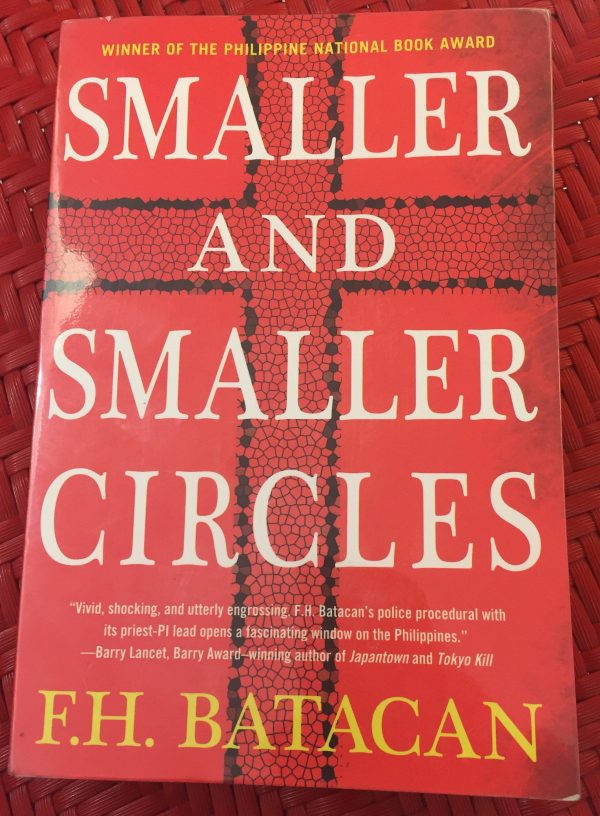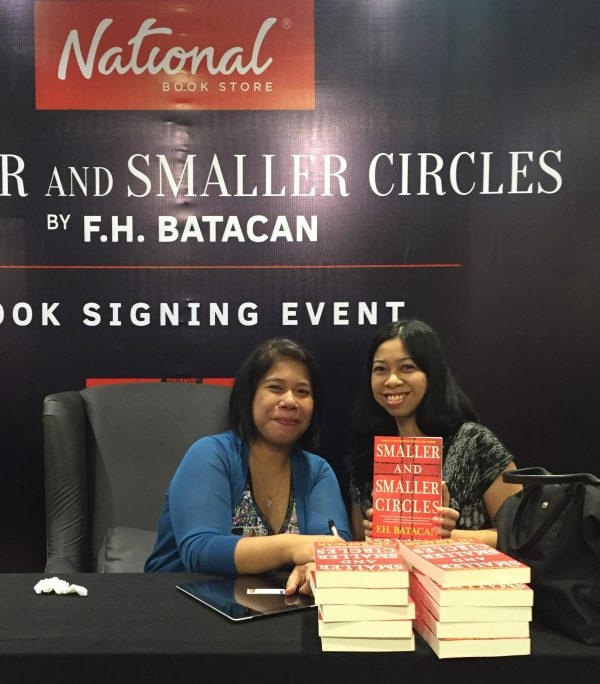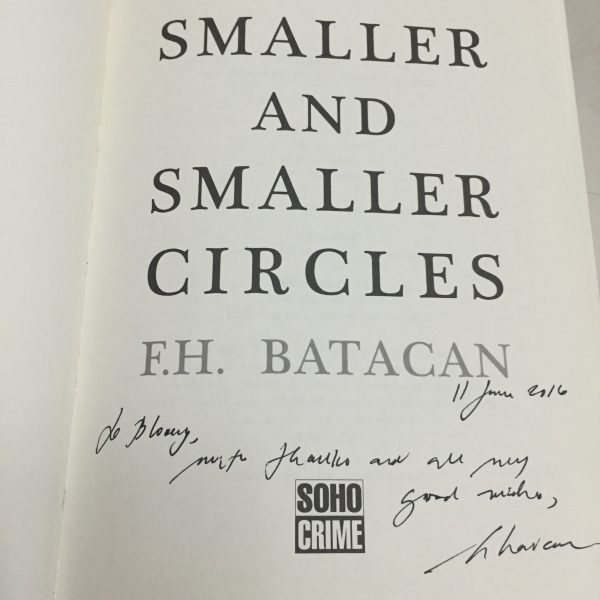
It was in 2013 when I first encountered the crime-solving Jesuit Fr. Gus Saenz in the anthology “Manila Noir,” where he appears in the story “Comforter of the Afflicted.” Not that he needed further introduction. I was in college when I first heard of the novella “Smaller and Smaller Circles,” although I was not able to get ahold of a copy until the Manila Noir book signing, when I and a bunch of other bloggers quickly foraged through the bookstore shelves for copies when we found out F.H. Batacan was at the event.
I read “Smaller and Smaller Circles” shortly after that, and I thought it was a great character study. I also liked the way it explored the nature of humanity and what pushes people over the edge. And when the expanded novel came out, I was quite curious to see what changes were made to the original manuscript. I read it in preparation for yesterday’s book signing and I wasn’t disappointed – there’s a lot more meat to this expanded edition – and I was glad to revisit the novel once more.

Here’s my short interview with F.H. Batacan:
What inspired you to write Smaller and Smaller Circles?
I was working at that time at a government intelligence agency, and for the first four years it was great. But the political winds changed; things went downhill. I was very unhappy with the way things were going with the agency. I was very disillutioned, and in a night of sheer frustration and insomnia I started banging away at the story, and the very first thing I wrote that night was that first chapter with the body in the dump. For me it was very much symbolic of the kind of rut I was seeing every day in my working life, but I couldn’t write about that so I had to find an oblique way of talking about my frustrations, so that was what started this.
How did the book get to be published, by UP Press and then by Soho Press?
I sent it to the Palanca Awards, but soon after it won I moved to Singapore so I didn’t know anybody who would publish it. UP Press said, “Talk to Me,” but there was so much on my mind, moving to another country. So I sat and tinkered with the book some more until Jing Hidalgo of UP Press said, “Where is it? Send it to me!” So I sent it to her for the UP Press Student Edition.
Many years later, I actually signed with a literary agency based in Singapore, Jacaranda, and they shopped around the original version. It was picked up by Soho Press but they suggested that it needs to be a bit longer for their market. For most of 2013, I moved back for a while to Manila and worked on the revisions for six months.
How was the experience of writing the same book twice, and how did you come up with the new content?
I had an editor who really went through the manuscript with a fine-tooth comb and made so many invaluable contributions and suggestions to the manuscript, one of which was to create a subplot, and that is one of the [key additions to the book].
It was difficult, and at the same time very satisfying to be able to improve on something I thought I was done with years ago.
Who served as the models for your main characters?
They’re really amalgamations of people I’ve known and met in my line of work. People who were very good at what they did, and brought new ideas to the agency or to their fields of work, but who are not necessarily allowed to find those environments hostile to new ideas. That is, I think, very much evident in the book, in the characters, and the way they interacted with one another.
How do you put faces to the victims?
I put faces to them in terms of people I have met. From the time I was a journalist, I have memories of women who’ve lost their sons, or women who’ve lived in poverty and struggled to raise children. The struggle is to make each victim – and Saenz says this in the book – more than just a piece of evidence. There’s a real person behind the victim, and as a writer you also have to convey that.
Are the details in the book all from your experience, or did you have to do a lot of research on the novel?
Research, research, research. A lot of research went into the first version; even more research went into the second version. You have to be really careful with things like dates, technology… even simple things like, “Did we have text messaging in the year so and so…” Things that you take for granted when you read a book, maybe one sentence of text, there’s probably hours of research that went into that.
Did you know “whodunit” from the start? Or did you see where the novel would take you?
The thing about ‘Circles,’ I’ve always said it’s a ‘whydunit.’ It’s really an examination of why this person has come to do what he’s been doing; it’s an examination of where society, institutions, and family have failed him. I always knew it was going to be this person, the question is how do you flesh out your reasons and the failures so it’s faithful to what we have in the country.
How were you approached for the upcoming film adaptation, and how do you feel about it?
The producers spoke to us through my agent, and there was an initial meeting in December last year. Since then I’ve been busy with my own work. They’ve managed to do everything so fast, and so efficient. It’s surreal. I can’t quite believe it, even if I’ve visited the set twice already. It’s like having an out of body experience.
The book has been dubbed as ‘the first Filipino crime novel’ – what do you think of this?
There have been previous novels that center around a crime. There’s “Cave and Shadows” by Nick Joaquin; Butch Dalisay has a novella… I think in terms of length and the expectations of a conventional crime fiction novel – and this is not something that I say for myself, it’s something that many literary scholars, all of them much smarter than I am, pretty much all of them have said that it’s the first that is skewed to that formula.
What would you advise to aspiring writers of this genre?
Stay true to the country. Kenneth Yu and I have worked on short anthologies of crime fiction, and many submissions we got were of the CSI type, and it’s not really reflective of the reality of the Philippines. If you read the book, everything is very low-tech. Even DNA in 1997 wasn’t an established technology. It’s really old-fashioned spadework. I think to do the country justice, you have to reflect the realities of law enforcement. Write faithfully about the country.
***
Oh, and what’s next for Fr. Gus? Listen to an excerpt from the next Fr. Saenz novel (working title: The Weight of Sin) – a prequel! – as read by the author herself at the book signing event:
***
Here I am with the author:

(Disclaimer: the stack isn’t mine!)
And I got my new copy signed, too:

***
And because I’ve been away all summer, here’s a new giveaway, a signed copy of Smaller and Smaller Circles. Join via Rafflecopter!
***
Special thanks to Chad and Sheza of National Book Store marketing for the interview.


Yay! Giveaway!
I enjoyed the original shorter version. I’d like to read this expanded edition.
JM, as the author said herself, this new edition is infinitely better than the first — I think you’ll enjoy it, too.
Good Job!
Thanks, Danry!
Hi Blooey!
I wish I were at the Smaller and Smaller Circles book signing event. I stalked National Book Store Cebu when I heard a second version of the book was released. I bought a copy as soon as it was available here, but a getting signed copy would be amazing! :)
Verne
FH Batacan is based in SG, so I’m glad I went to the book signing and had the opportunity to interview. Wishing you luck for this giveaway!
I wish more people would read Smaller and Smaller Circles. I can’t wait to watch the film adaptation.
Oonaj, looking forward to watching it on the big screen, too :)
I’d like an autographed copy!
Hi Anna, your IP address seems to be in the US — I’m sorry but this is a PH only giveaway. It would cost more to send the book abroad than the cover price of the book.
I’ve been meaning to purchase this book for a while now, but I couldn’t get a hold of a copy. I meant to go last Saturday, but sched conflict prevented me from going. I really wanted a signed copy. Just the same, I’ll probably buy one anyway if I don’t win Hehe
Art, I think you’ll find things in common with Fr. Gus :)
Smaller and Smaller Circles seems to be an interesting book to read. I love your interview Miss Blooey and you are so lucky that your book have been signed! :)
It is :) Hope you get to read it, Paula
Great.. Thanks for the chance
You’re welcome, Maricel
Hope I get the book! Would love to see the differences between the UP Press edition which I have read and this new one. :-)
Yay, you made it! Good luck, Mike! :)
Great interview, Blooey!
I loved the first edition of the book, and I’m excited to read the expanded edition.